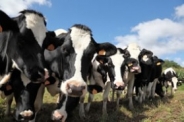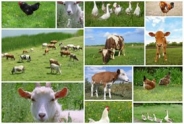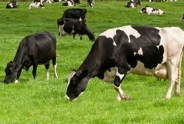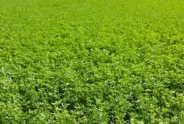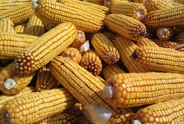Are You Milking Some Cows You Shouldn't Be?
By Joan Sinclair Petzen, John Hanchar and Andrew Novakovic
Your extension team has been working remotely toward the goal of getting pertinent information into your hands, information to help your business make decisions in light of new and uncertain circumstances of the COVID-19 Pandemic. In a suddenly changed price environment, where the all milk price projected in the World Supply and Demand Estimates from USDA (https://www.usda.gov/oce/commodity/wasde/) dropped by $3.90 per cwt. from their March to April 2020 report. Managers need to make decisions to preserve cash and meet their financial commitments.
To guide decision making, consider reviewing resources available from Pro-DAIRY including: publications, podcasts, and webinars; to spark discussions with your management team for responding to COVID-19.
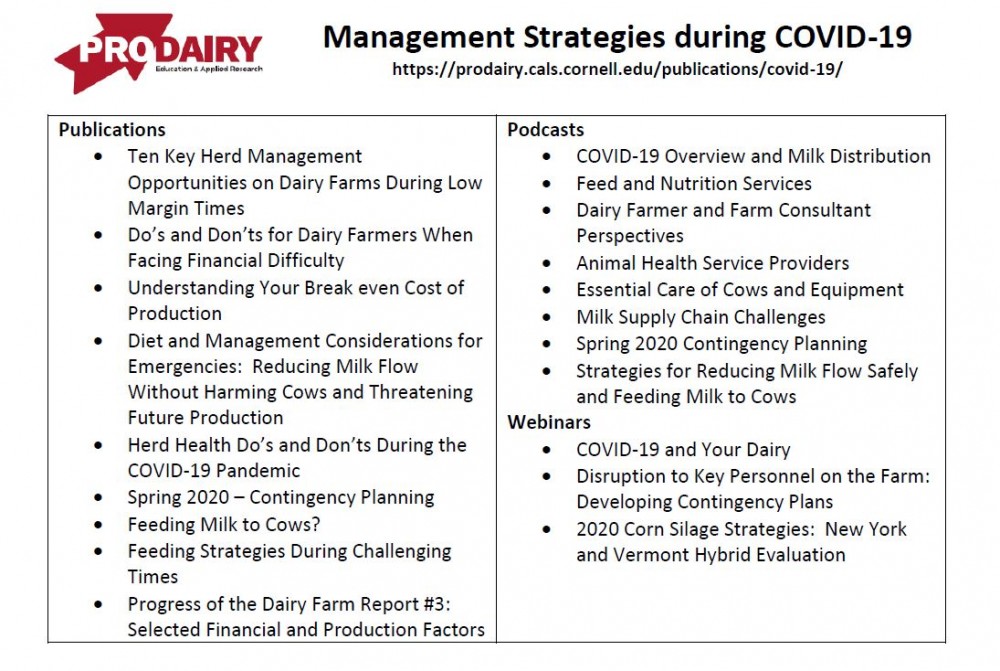
History often provides good instruction when trying to size up an unfamiliar situation, shedding some light on current options. Key highlights of historical agricultural policies designed to achieve a safe, stable, affordable milk supply follow.
The 1984 Milk Diversion Program (MDP), created in a period of extraordinary surpluses and price pressure, sought to quickly and partially reduce milk production, over 15 months, by giving farms cash incentives to reduce production. This program is similar to what was recently proposed by the National Milk Producer Federation and International Dairy Foods Association.
Going into the MDP many barns were overcrowded and farms were raising every heifer calf to continue to grow. Producers, who subscribed, quickly implemented plans to reduce their variable costs by changing rations and culling a few extra cows each month. Many found they needed to cull more cows than their plan called for to reach their reduced production goal. MDP was costly for taxpayers, ultimately did not achieve its goals, and led to the old Dairy Termination Program, under which whole herds were bought out and farms were retired.
The current challenge is to shore up prices that have collapsed because of the near shut down in the almost one-half of our market; dairy foods eaten outside of the home. Nevertheless, the management strategies used under the old MDP provide some food for thought relevant to today.
On New York dairy farms, feed is the single largest cost of doing business. Purchased grain and roughage, plus direct costs of producing forage -- seed, fertilizer, lime and spray expenses -- account for 40% of the cost of operating a dairy farm (preliminary data from 131 same farms completing a Cornell Dairy Farm Business Summary for 2018 and 2019). Hired labor accounts for another 17% of the operating costs for these dairies. Both of these variable expenses can be reduced in the short run if animal numbers are trimmed with the purpose of improving net cash income given prices.
With the recent quick downturn in milk price and future expectations, each farm must take a hard look at each unit, cow, and determine whether that cow will cover variable costs and contribute to supporting fixed costs. So, do you have cows with udder health issues that might be preventing you from receiving the highest level of quality incentive? That's usually 25 to 30 cents per hundredweight on all the milk going out the door. What about hard breeders? Those are cows that will be tail-enders for several months and may not be contributing much beyond their variable costs. What about those cows you know are carrying twins and are more prone to post calving problems like retained placenta, ketosis or displaced abomasum? Can you afford to take a chance on carrying them through the dry period? What about cows in the lowest 10% of the herd for mature equivalent milk production? If you were to cull a few extra of these cows one week, then observe the impact on the total pounds of milk going out the door, what would the outcome be from revenue and cost perspectives? Especially if you barn is overcrowded, you might be surprised to find that you don't even miss those cows.
Another good place to look is in the heifer barn. Do you need them all? Unless you have plans to grow your herd in the next couple of years, it is critical to determine how many heifer calves you need to start each month to have plenty of replacements to meet your herd needs. With heifer prices where they are now, few farms are able to profit by selling extra heifers they don't need for replacements.
The price structure for feed is also changing. With ethanol production dropping off, along with demand for gasoline, dried distillers grain supplies are tightening. Soybean meal may be a better bargain in the short run. Now is the time to sit down with your nutritionist to take stock of your home grown feed inventories and forage needs until the next harvest. Fine tune the ration and be certain you are saving where it makes sense, choosing the right ingredients and using your inventories to the best advantage.
The bottom line, to improve the business' ability to meet cash obligations when the price structure changes quickly and dramatically, it makes sense to reevaluate management strategies you might otherwise be taking for granted (see the PRO-DAIRY resources mentioned above). Your business must be nimble and ready to change production practices to bring costs in line with the prices you are receiving and paying. Typically we strive for high rates of production per cow and keep barns full, or more than full, as a way to spread fixed costs over more milk. Strategies should be revisited and rechecked given the collapse in milk prices.
Changes do not need to be drastic. Maybe a little more disciplined approach to decision
making increases the likelihood of success.
- Evaluate each cow before you invest in dry treatment or another straw of semen.
- On the heifer side, determine whether each calf has the potential to improve overall herd performance when she reaches productive age and choose which ones to raise.
- Take a hard look to be sure you are getting the most bang for the buck from your ration.
Implementing these practices may help to improve margins
given the dramatic changes in milk prices.
Today the prospects for market recovery are much better than that they
were in the early 1980s. Eventually, markets will reopen and sales will
return. In the meantime, we don't need
to put farms out of business, but easing back on the throttle in how we manage
cows and how many cows we keep could be good strategies for the current
situation.
Are You Milking Some Cows You Shouldn't Be? (pdf; 468KB)
- Full article in PDF format
Upcoming Events
Cornell Cow Convos Podcast- Episode 8 Release
April 25, 2024
Cornell Cow Convos-Episode 8
Western NY Value-Added Dairy Discussion Group: Jess May- Farm Credit East Webinar
May 2, 2024 : Value-Added Dairy Discussion Group Webinar: Jess May- Farm Credit East
Register here:
https://cornell.zoom.us/webina...
Western NY Value-Added Dairy Discussion Group: Eden Valley Creamery
May 3, 2024
South Dayton, NY
Registration for this discussion group is required and limited.

